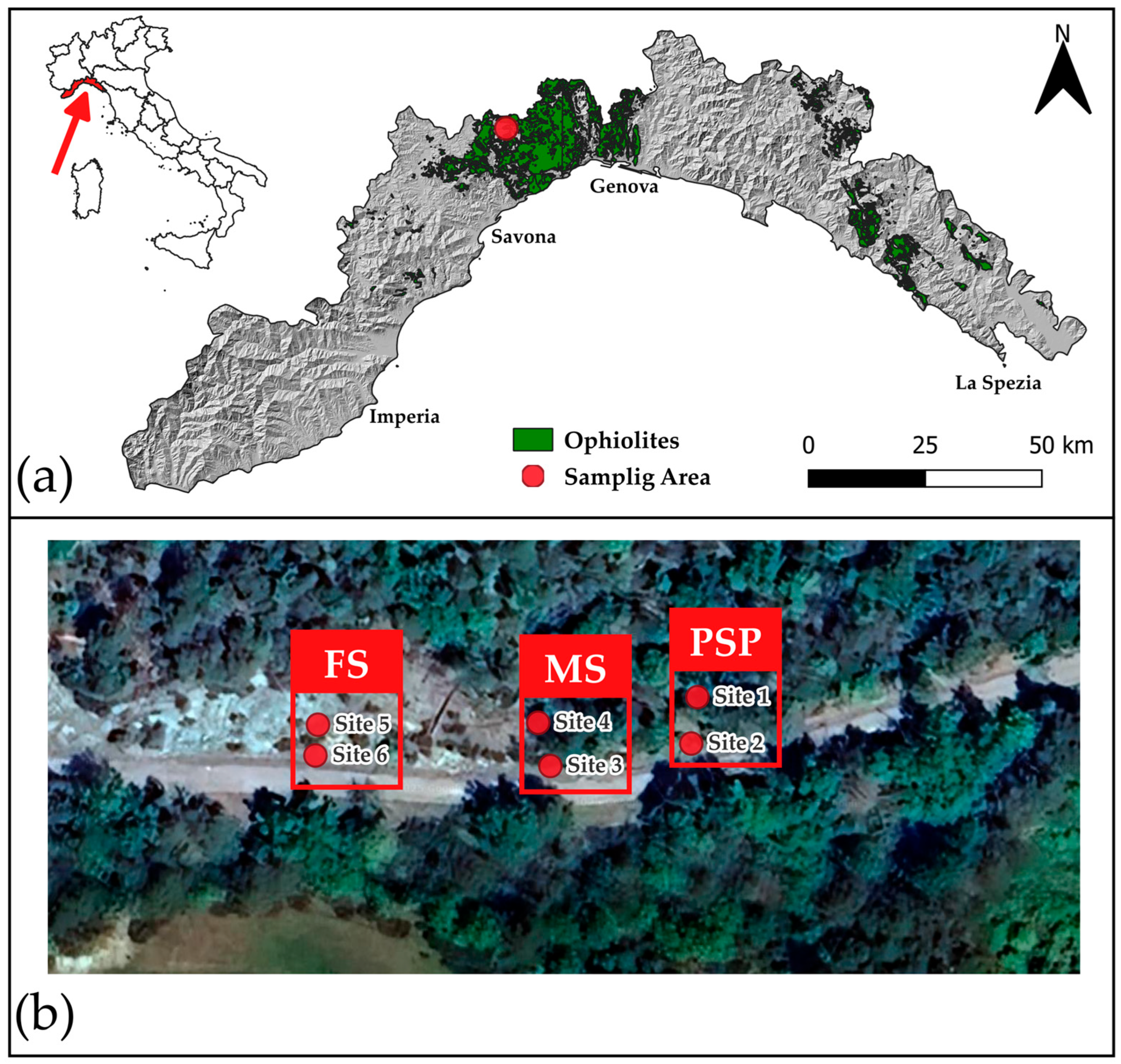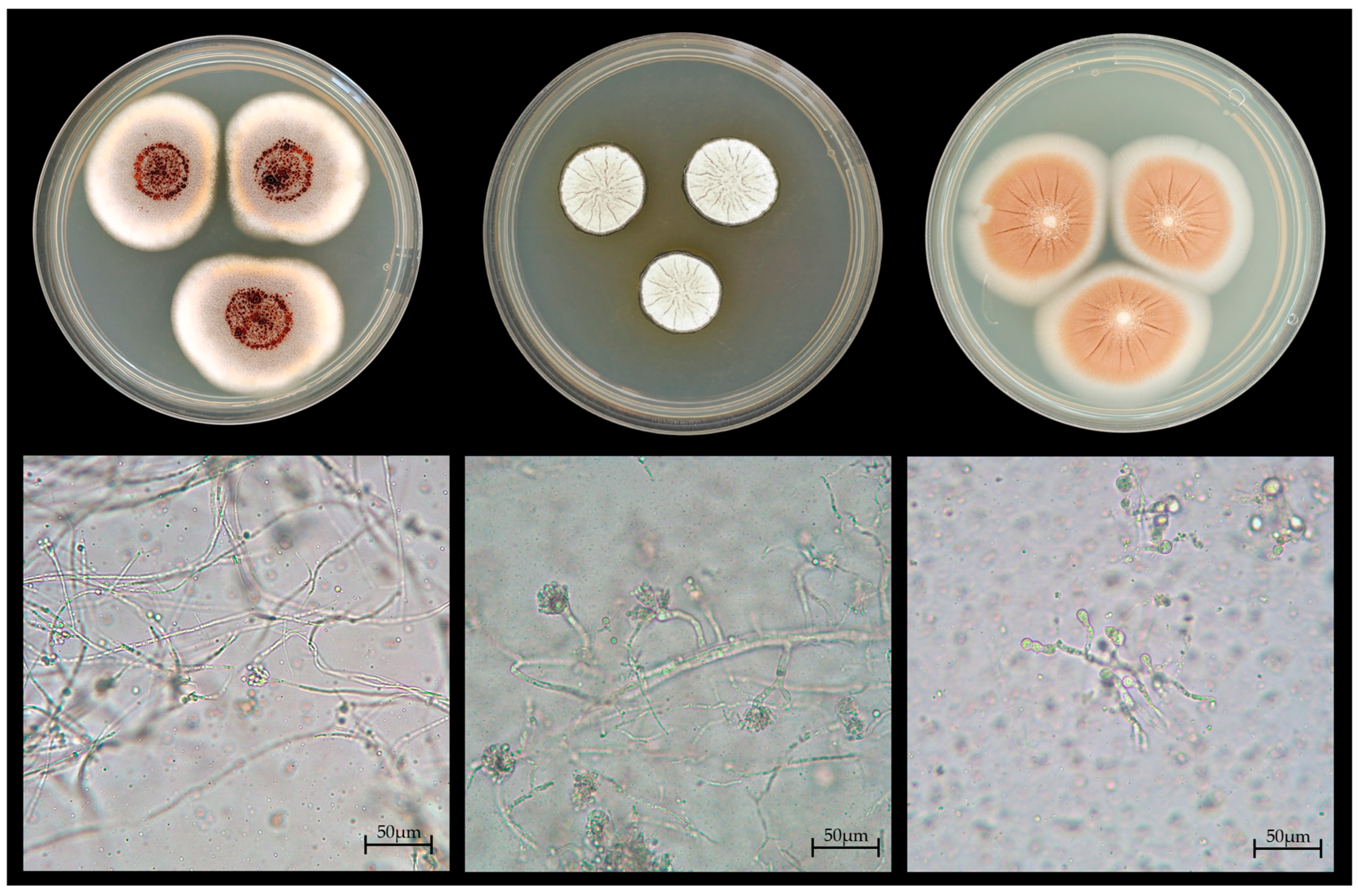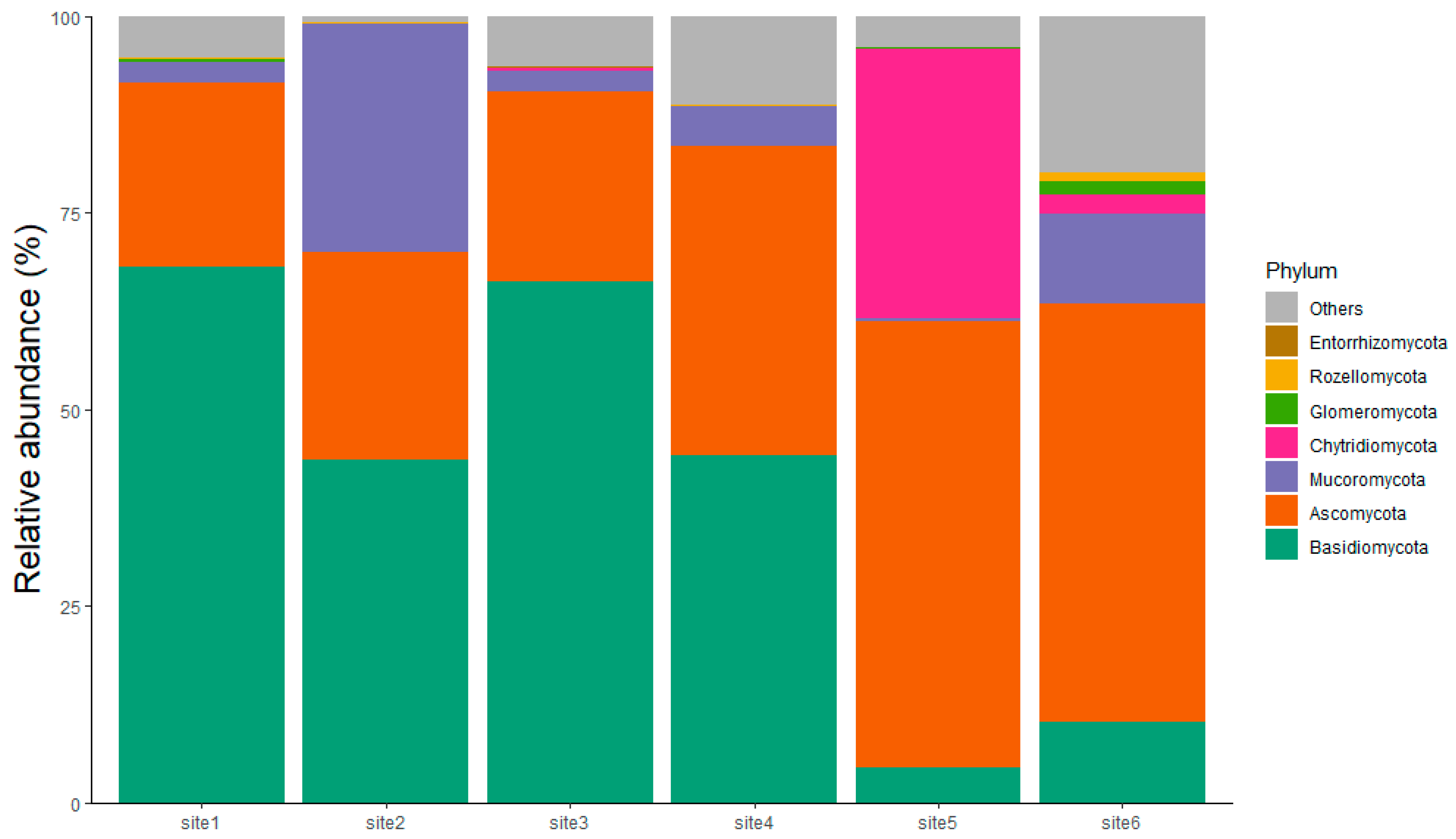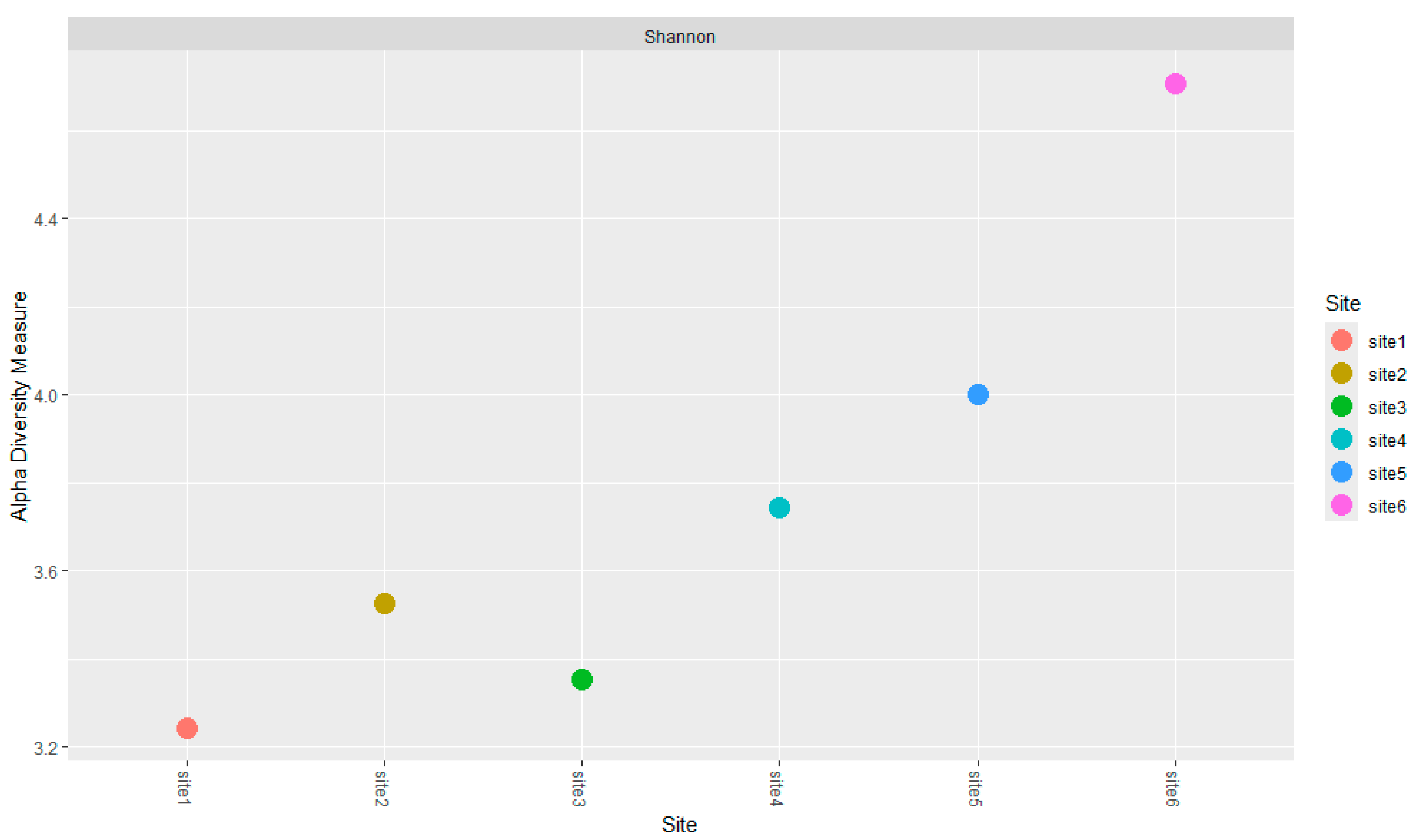Fungi and Potentially Toxic Elements (PTEs): Exploring Mycobiota in Serpentinite Soils
Abstract
1. Introduction
2. Materials and Methods
2.1. Sampling Points and Collection of Soil Samples
2.2. Chemical Characterization
2.3. Mycological Characterization Processing
3. Results and Discussion
3.1. Chemical Characterization of Soil
3.2. Mycological Characterization
4. Conclusions
Supplementary Materials
Author Contributions
Funding
Data Availability Statement
Acknowledgments
Conflicts of Interest
Abbreviations
| FS | foliated serpentinite |
| MS | massive serpentinite |
| PSP | partially serpentinized peridotite |
| PTE | potentially toxic element |
References
- Shu, W.-S.; Huang, L.-N. Microbial Diversity in Extreme Environments. Nat. Rev. Microbiol. 2022, 20, 219–235. [Google Scholar] [CrossRef]
- Sepe, F.; Costanzo, E.; Ionata, E.; Marcolongo, L. Biotechnological Potential of Extremophiles: Environmental Solutions, Challenges, and Advancements. Biology 2025, 14, 847. [Google Scholar] [CrossRef]
- Rothschild, L.; Mancinelli, R.L. Insight Review Articles. Nature 2001, 409, 1092–1101. [Google Scholar] [CrossRef]
- Satyanarayana, T.; Raghukumar, C.; Shivaji, S. Extremophilic Microbes: Diversity and Perspectives. Curr. Sci. 2005, 89, 78–90. [Google Scholar]
- Jeong, S.W.; Choi, Y.J. Extremophilic Microorganisms for the Treatment of Toxic Pollutants in the Environment. Molecules 2020, 25, 4380. [Google Scholar] [CrossRef] [PubMed]
- Cheng, K.-W.; Yang, J.; Srimongkol, P.; Stadler, M.; Karnchanatat, A.; Ariyawansa, H.A. Fungal Frontiers in Toxic Terrain: Revealing Culturable Fungal Communities in Serpentine Paddy Fields of Taiwan. IMA Fungus 2025, 16, e155308. [Google Scholar] [CrossRef] [PubMed]
- Oze, C.; Fendorf, S.; Bird, D.K.; Coleman, R.G. Chromium Geochemistry of Serpentine Soils. Int. Geol. Rev. 2004, 46, 97–126. [Google Scholar] [CrossRef]
- Alexander, E.B. Serpentine Geoecology of Western North America: Geology, Soils, and Vegetation; Oxford University Press: New York, NY, USA, 2007. [Google Scholar]
- Proctor, J.; Woodell, S.R.J. The Ecology of Serpentine Soils. Adv. Ecol. Res. 1975, 9, 255–366. [Google Scholar] [CrossRef]
- Van Volkenburgh, E. Physiological Adaptations of Plants to Serpentine Soil. Plant Soil 2014, 382, 83–94. [Google Scholar]
- Branco, S.; Ree, R.H. Serpentine Soils Do Not Limit Mycorrhizal Fungal Diversity. PLoS ONE 2010, 5, e11757. [Google Scholar] [CrossRef]
- Brouwer, F.M.; Vissers, R.L.M.; Lamb, W.M. Metamorphic History of Eclogitic Metagabbro Blocks from a Tectonic Mélange in the Voltri Massif, Ligurian Alps, Italy. Ofioliti 2002, 27, 1–16. [Google Scholar]
- UENC for, E. Structural and Metamorphic Signature of Alpine Tectonics in the Voltri Massif (Ligurian Alps, North-Western Italy). Geol. J. 2009, 44, 132–145. [Google Scholar] [CrossRef]
- Fornasaro, S.; Comodi, P.; Crispini, L.; Malatesta, C.; Zucchini, A.; Marescotti, P. Potentially Toxic Elements Distribution in the Serpentinized and Deformed Ultramafic Rocks from the Voltri Massif (NW, Italy). Period. Mineral 2023, 88, 259–276. [Google Scholar] [CrossRef]
- Abd Elnabi, M.K.; Elkaliny, N.E.; Elyazied, M.M.; Azab, S.H.; Elkhalifa, S.A.; Elmasry, S.; Mouhamed, M.S.; Shalamesh, E.M.; Alhorieny, N.A.; Abd Elaty, A.E.; et al. Toxicity of Heavy Metals and Recent Advances in Their Removal: A Review. Toxics 2023, 11, 580. [Google Scholar] [CrossRef]
- Kumar, V.; Dwivedi, S.K. Mycoremediation of Heavy Metals: Processes, Mechanisms, and Affecting Factors. Environ. Sci. Pollut. Res. 2021, 28, 2785–2805. [Google Scholar] [CrossRef]
- Fu, Z.; Xi, S. The Effects of Heavy Metals on Human Metabolism. Toxicol. Mech. Methods 2020, 30, 167–176. [Google Scholar] [CrossRef]
- Tchounwou, P.B.; Yedjou, C.G.; Patlolla, A.K.; Sutton, D.J. Heavy Metal Toxicity and the Environment. EXS 2012, 101, 133–164. [Google Scholar] [CrossRef]
- Harrison, S.P.; Rajakaruna, N. Serpentine: The Evolution and Ecology of a Model System; University of California Press: Oakland, CA, USA, 2011; pp. 80–83. [Google Scholar]
- Hysa, A.; Teqja, Z.; Bani, A.; Libohova, Z.; Cerda, A. Assessing Wildfire Vulnerability of Vegetated Serpentine Soils in the Balkan Peninsula. J. Nat. Conserv. 2022, 68, 126217. [Google Scholar] [CrossRef]
- Mengoni, A.; Barzanti, R.; Gonnelli, C.; Gabbrielli, R.; Bazzicalupo, M. Characterization of nickel-resistant bacteria isolated from serpentine soil. Environ. Microbiol. 2001, 3, 691–698. [Google Scholar] [CrossRef]
- Abou-Shanab, R.A.I.; van Berkum, P.; Angle, J.S. Heavy metal resistance and genotypic analysis of metal resistance genes in gram-positive and gram-negative bacteria present in Ni-rich serpentine soil and in the rhizosphere of Alyssum murale. Chemosphere 2007, 68, 360–367. [Google Scholar] [CrossRef]
- Iram, S.; Parveen, K.; Usman, J.; Nasir, K.; Akhtar, N.; Arouj, S.; Ahmad, I. Heavy metal tolerance of filamentous fungal strains isolated from soil irrigated with industrial wastewater. Biologija 2012, 58, 107–116. [Google Scholar] [CrossRef]
- Álvarez-López, V.; Prieto-Fernández, Á.; Becerra-Castro, C.; Monterroso, C.; Kidd, P.S. Rhizobacterial communities associated with the flora of three serpentine outcrops of the Iberian Peninsula. Plant Soil 2016, 403, 233–252. [Google Scholar] [CrossRef]
- Gadd, G.M. Interactions of fungi with toxic metals. New Phytol. 1993, 124, 25–60. [Google Scholar] [CrossRef]
- de Lima e Silva, A.A.; Ribeiro de Carvalho, M.A.; L de Souza, S.A.L.; Teixeira Dias, P.M.; da Silva Filho, R.G.; de Meirelles Saramago, C.S.; de Melo Bento, C.A.; Hofer, E. Heavy metal tolerance (Cr, Ag and Hg) in bacteria isolated from sewage. Braz. J. Microbiol. 2012, 43, 1620–1631. [Google Scholar] [CrossRef]
- Liao, M.; Xie, X.M. Effect of heavy metals on substrate utilization pattern, biomass, and activity of microbial communities in a reclaimed mining wasteland of red soil area. Ecotoxicol. Environ. Saf. 2007, 66, 217–223. [Google Scholar] [CrossRef] [PubMed]
- Kelly, J.J.; Iii, R.L.T. Effects of Heavy Metal Contamination and Remediation on Soil Microbial Communities in the vicinity of a Zinc smelter. J. Environ. Qual. 1998, 27, 609–617. [Google Scholar] [CrossRef]
- Coleine, C.; Stajich, J.E.; Selbmann, L. Fungi are key players in extreme ecosystems. Trends Ecol. Evol. 2022, 37, 517–528. [Google Scholar] [CrossRef]
- Orellana, R.; Macaya, C.; Bravo, G.; Dorochesi, F.; Cumsille, A.; Valencia, R.; Rojas, C.; Seeger, M. Living at the Frontiers of Life: Extremophiles in Chile and Their Potential for Bioremediation. Front. Microbiol. 2018, 9, 2309. [Google Scholar] [CrossRef] [PubMed]
- Cecchi, G.; Vagge, G.; Cutroneo, L.; Greco, G.; Di Piazza, S.; Faga, M.; Zotti, M. Fungi as potential tool for polluted port sediment remediation. Environ. Sci. Pollut. Res. 2019, 26, 35602–35609. [Google Scholar] [CrossRef]
- Azubuike, C.C.; Chikere, C.B.; Okpokwasili, G.C. Bioremediation of Industrial Waste for Environmental Safety; Springer: Singapore, 2020. [Google Scholar]
- Pandey, N.; Chandrakar, V.; Keshavkant, S. Mitigating Arsenic Toxicity in Plants: Role of Microbiota. In Mechanisms of Arsenic Toxicity and Tolerance in Plants; Springer: Singapore, 2018; pp. 191–218. [Google Scholar] [CrossRef]
- Robinson, J.R.; Isikhuemhen, O.S.; Anike, F.N. Fungal–Metal Interactions: A Review of Toxicity and Homeostasis. J. Fungi 2021, 7, 225. [Google Scholar] [CrossRef]
- Harms, H.; Schlosser, D.; Wick, L.Y. Untapped potential: Exploiting fungi in bioremediation of hazardous chemicals. Nat. Rev. Microbiol. 2011, 9, 177–192. [Google Scholar] [CrossRef]
- Liang, X.; Gadd, G.M. Metal and metalloid biorecovery using fungi. Microb. Biotechnol. 2017, 10, 1199–1205. [Google Scholar] [CrossRef]
- Cecchi, G.; Marescotti, P.; Di Piazza, S.; Zotti, M. Native fungi as metal remediators: Silver myco-accumulation from metal contaminated waste-rock dumps (Libiola Mine, Italy). J. Environ. Sci. Health Part B 2017, 52, 191–195. [Google Scholar] [CrossRef]
- Lu, M.; Wang, X.; Li, Y.; Liu, H.; An, X.; Lian, B. Soil microbial community structure and environmental effects of serpentine weathering under different vegetative covers in the serpentine mining area of Donghai County, China. Sci. Total Environ. 2022, 835, 155452. [Google Scholar] [CrossRef]
- Google Earth. Imagery of Sampling Area on Voltri Massif. Available online: https://earth.google.com (accessed on 4 September 2023).
- World Reference Base for Soil Resources 2014: International Soil Classification System for Naming Soils and Creating Legends for Soil Maps. Available online: https://www.researchgate.net/publication/266065065_World_Reference_Base_for_soil_resources_2014_international_soil_classification_system_for_naming_soils_and_creating_legends_for_soil_maps (accessed on 10 September 2025).
- Marescotti, P.; Comodi, P.; Crispini, L.; Gigli, L.; Zucchini, A.; Fornasaro, S. Potentially Toxic Elements in Ultramafic Soils: A Study from Metamorphic Ophiolites of the Voltri Massif (Western Alps, Italy). Minerals 2019, 9, 502. [Google Scholar] [CrossRef]
- Albanese, S.; Sadeghi, M.; Lima, A.; Cicchella, D.; Dinelli, E.; Valera, P.; Falconi, M.; Demetriades, A.; De Vivo, B.; Andersson, M.; et al. GEMAS: Cobalt, Cr, Cu and Ni Distribution in Agricultural and Grazing Land Soil of Europe. J. Geochem. Explor. 2015, 154, 81–93. [Google Scholar] [CrossRef]
- Geoportale Regione Liguria. Available online: https://geoportal.regione.liguria.it (accessed on 14 October 2025).
- Pitt, J.I.; Hocking, A.D. Fungi and Food Spoilage, 3rd ed.; Springer: New York, NY, USA, 2009. [Google Scholar]
- Chen, A.J.; Hubka, V.; Frisvad, J.C.; Visagie, C.M.; Houbraken, J.; Meijer, M.; Varga, J.; Demirel, R.; Jurjević, Z.; Kubátová, A.; et al. Polyphasic Taxonomy of Aspergillus Section Aspergillus (Formerly Eurotium), and Its Occurrence in Indoor Environments and Food. Stud. Mycol. 2017, 88, 37–135. [Google Scholar] [CrossRef] [PubMed]
- Bissett, J. A Revision of the Genus Trichoderma. I. Section Longibrachiatum Sect. Nov. Can. J. Bot. 1984, 62, 924–931. [Google Scholar] [CrossRef]
- Doyle, J.J.; Doyle, J.L. A Rapid DNA Isolation Procedure for Small Quantities of Fresh Leaf Tissue. Phytochem. Bull. 1987, 19, 11–15. [Google Scholar]
- Di Piazza, S.; Houbraken, J.; Meijer, M.; Cecchi, G.; Kraak, B.; Rosa, E.; Zotti, M. Thermotolerant and Thermophilic Mycobiota in Different Steps of Compost Maturation. Microorganisms 2020, 8, 880. [Google Scholar] [CrossRef] [PubMed]
- Bolyen, E.; Rideout, J.R.; Dillon, M.R.; Bokulich, N.A.; Abnet, C.C.; Al-Ghalith, G.A.; Alexander, H.; Alm, E.J.; Arumugam, M.; Asnicar, F.; et al. Reproducible, Interactive, Scalable and Extensible Microbiome Data Science Using QIIME 2. Nat. Biotechnol. 2019, 37, 852–857. [Google Scholar] [CrossRef] [PubMed]
- Callahan, B.J.; McMurdie, P.J.; Rosen, M.J.; Han, A.W.; Johnson, A.J.A.; Holmes, S.P. DADA2: High-Resolution Sample Inference from Illumina Amplicon Data. Nat. Methods 2016, 13, 581–583. [Google Scholar] [CrossRef]
- Shannon, C.E. A Mathematical Theory of Communication. Bell Syst. Tech. J. 1948, 27, 379–423. [Google Scholar] [CrossRef]
- McMurdie, P.J.; Holmes, S. phyloseq: An R package for reproducible interactive analysis and graphics of microbiome census data. PLoS ONE 2013, 8, e61217. [Google Scholar] [CrossRef]
- Pernet, C.R.; Wilcox, R.; Rousselet, G.A. Robust Correlation Analyses: False Positive and Power Validation Using a New Open Source MATLAB Toolbox. Front. Psychol. 2013, 3, 606. [Google Scholar] [CrossRef]
- Legislative Decree No. 152 of April 3, 2006, Annex 5, Part IV, Title V: Remediation of Contaminated Sites (Official Gazette No. 88, Ordinary Supplement No. 96 of April 14, 2006). Available online: https://www.gazzettaufficiale.it/dettaglio/codici/materiaAmbientale (accessed on 5 November 2022).
- Huang, J.N.; Zou, Q.; Chen, J.; Xu, S.H.; Luo, D.; Zhang, F.G.; Lu, Y.Y. Phenols and Diketopiperazines Isolated from Antarctic-Derived Fungi, Penicillium citreonigrum SP-6. Phytochem. Lett. 2018, 27, 114–118. [Google Scholar] [CrossRef]
- Bovio, E.; Gnavi, G.; Prigione, V.; Spina, F.; Denaro, R.; Yakimov, M.; Calogero, R.; Crisafi, F.; Varese, G.C. The Culturable Mycobiota of a Mediterranean Marine Site after an Oil Spill: Isolation, Identification and Potential Application in Bioremediation. Sci. Total Environ. 2017, 576, 310–318. [Google Scholar] [CrossRef]
- Cruz, R.; Santos, C.; de Lima, J.S.; Moreira, K.A.; de Souza-Motta, C.M. Diversity of Penicillium in Soil of Caatinga and Atlantic Forest Areas of Pernambuco, Brazil: An Ecological Approach. Nova Hedwigia 2013, 97, 543–556. [Google Scholar] [CrossRef]
- Levinskaitė, L. Biodegradation Potential of Penicillium Isolated from Synthetic Polymeric Materials. J. Environ. Eng. 2018, 144, 06018002. [Google Scholar] [CrossRef]
- Uchiyama, Y.; Takino, M.; Noguchi, M.; Shiratori, N.; Kobayashi, N.; Sugita-Konishi, Y. The In Vivo and In Vitro Toxicokinetics of Citreoviridin Extracted from Penicillium citreonigrum. Toxins 2019, 11, 360. [Google Scholar] [CrossRef]
- Ali, F.T.; El-Sheikh, H.H.; El-Hady, M.M.; Elaasser, M.M.; El-Agamy, D.M. Silver Nanoparticles Synthesized by Penicillium citreonigrum and Fusarium moniliforme Isolated from El-Sharkia, Egypt. Int. J. Sci. Eng. Res. 2014, 5, 181–192. [Google Scholar]
- Hamad, M.T. Biosynthesis of Silver Nanoparticles by Fungi and Their Antibacterial Activity. Int. J. Environ. Sci. Technol. 2019, 16, 1015–1024. [Google Scholar] [CrossRef]
- Hou, D.; Tang, D.; Wang, Y.; Zhu, J.; Luo, R.; Liu, Z.; Lu, Y.; Sun, T.; Ma, Y.; Zhang, Y.; et al. Molecular Phylogenetics of the Umbelopsis Genus—Identification of New Species and Evaluation of Their Oil Application Value. J. Appl. Microbiol. 2024, 135, lxae065. [Google Scholar] [CrossRef]
- Wong, L.C.; Rodenburg, U.; Leite, R.R.; Korthals, G.W.; Pover, J.; Koerten, H.; Kuramae, E.E.; Bodelier, P.L.E. Exploring Microbial Diversity and Interactions for Asbestos Modifying Properties. Sci. Total Environ. 2024, 951, 175577. [Google Scholar] [CrossRef] [PubMed]
- Janicki, T.; Długoński, J.; Krupiński, M. Detoxification and Simultaneous Removal of Phenolic Xenobiotics and Heavy Metals with Endocrine-Disrupting Activity by the Non-Ligninolytic Fungus Umbelopsis isabellina. J. Hazard. Mater. 2018, 360, 661–669. [Google Scholar] [CrossRef]
- Zhu, S.; Bonito, G.; Chen, Y.; Du, Z.Y. Oleaginous Fungi in Biorefineries. Ref. Modul. Life Sci. 2020, 2, 577–589. [Google Scholar] [CrossRef]
- Daghino, S.; Murat, C.; Sizzano, E.; Girlanda, M.; Perotto, S. Fungal Diversity Is Not Determined by Mineral and Chemical Differences in Serpentine Substrates. PLoS ONE 2012, 7, e44233. [Google Scholar] [CrossRef]
- Nguyen, H.T.; Yu, N.H.; Jeon, S.J.; Lee, H.W.; Bae, C.H.; Yeo, J.H.; Lee, H.B.; Kim, I.S.; Park, H.W.; Kim, J.C. Antibacterial Activities of Penicillic Acid Isolated from Aspergillus persii against Various Plant Pathogenic Bacteria. Lett. Appl. Microbiol. 2016, 62, 488–493. [Google Scholar] [CrossRef]
- Pal, A.; Ghosh, S.; Paul, A.K. Biosorption of Cobalt by Fungi from Serpentine Soil of Andaman. Bioresour. Technol. 2005, 96, 1335–1342. [Google Scholar] [CrossRef] [PubMed]
- Shugaba, A.; Wuyep, P.A.; Nok, A.J.; Ameh, D.A.; Lori, J.A. Bioremediation of Hexavalent Chromium and Tannic Acid in Synthetic Tannery Wastewater Using Free and Calcium Alginate-Immobilized Spores and Mycelia of Aspergillus niger and Aspergillus parasiticus. Bioremediat. J. 2010, 14, 142–149. [Google Scholar] [CrossRef]
- McClain, C.N.; Fendorf, S.; Webb, S.M.; Maher, K. Quantifying Cr(VI) Production and Export from Serpentine Soil of the California Coast Range. Environ. Sci. Technol. 2017, 51, 141–149. [Google Scholar] [CrossRef]
- Chen, A.J.; Varga, J.; Frisvad, J.C.; Jiang, X.Z.; Samson, R.A. Polyphasic Taxonomy of Aspergillus Section Cervini. Stud. Mycol. 2016, 85, 65–89. [Google Scholar] [CrossRef]
- Wubet, T.; Christ, S.; Schöning, I.; Boch, S.; Gawlich, M.; Schnabel, B.; Fischer, M.; Buscot, F. Differences in Soil Fungal Communities between European Beech (Fagus sylvatica L.) Dominated Forests Are Related to Soil and Understory Vegetation. PLoS ONE 2012, 7, e47500. [Google Scholar] [CrossRef]
- Zhong, Z.; Zhang, X.; Wang, X.; Fu, S.; Wu, S.; Lu, X.; Ren, C.; Han, X.; Yang, G. Soil Bacteria and Fungi Respond Differently to Plant Diversity and Plant Family Composition during the Secondary Succession of Abandoned Farmland on the Loess Plateau, China. Plant Soil 2020, 448, 183–200. [Google Scholar] [CrossRef]
- Wallen, R.M.; Perlin, M.H. An Overview of the Function and Maintenance of Sexual Reproduction in Dikaryotic Fungi. Front. Microbiol. 2018, 9, 503. [Google Scholar] [CrossRef]
- Egidi, E.; Delgado-Baquerizo, M.; Plett, J.M.; Wang, J.; Eldridge, D.J.; Bardgett, R.D.; Maestre, F.T.; Singh, B.K. A Few Ascomycota Taxa Dominate Soil Fungal Communities Worldwide. Nat. Commun. 2019, 10, 2369. [Google Scholar] [CrossRef] [PubMed]
- Camenzind, T.; Weimershaus, P.; Lehmann, A.; Aguilar-Trigueros, C.; Rillig, M.C. Soil Fungi Invest into Asexual Sporulation under Resource Scarcity, but Trait Spaces of Individual Isolates Are Unique. Environ. Microbiol. 2022, 24, 2962–2978. [Google Scholar] [CrossRef]
- Botha, D.; Barnard, S.; Claassens, S.; Rajakaruna, N.; Venter, A.; Ismail, A.; Allam, M.; Siebert, S.J. Soil Type and Precipitation Level Have a Greater Influence on Fungal than Bacterial Diversity in Serpentine and Non-Serpentine Biological Soil Crusts. Ecol. Res. 2024, 39, 862–878. [Google Scholar] [CrossRef]
- Pan, X.; Zhang, S.; Zhong, Q.; Gong, G.; Wang, G.; Guo, X.; Xu, X. Effects of Soil Chemical Properties and Fractions of Pb, Cd, and Zn on Bacterial and Fungal Communities. Sci. Total Environ. 2020, 715, 136904. [Google Scholar] [CrossRef] [PubMed]
- Kapahi, M.; Sachdeva, S. Bioremediation Options for Heavy Metal Pollution. J. Health Pollut. 2019, 9, 191203. [Google Scholar] [CrossRef]
- Newsome, L.; Falagán, C. The Microbiology of Metal Mine Waste: Bioremediation Applications and Implications for Planetary Health. GeoHealth 2021, 5, e2020GH000319. [Google Scholar] [CrossRef]
- Kazakou, E.; Dimitrakopoulos, P.G.; Baker, A.J.M.; Reeves, R.D.; Troumbis, A.Y. Hypotheses, Mechanisms and Trade-Offs of Tolerance and Adaptation to Serpentine Soils: From Species to Ecosystem Level. Biol. Rev. 2008, 83, 495–508. [Google Scholar] [CrossRef]




| V | Cr | Co | Ni | Cu | Zn | Cd | Pb | ||
|---|---|---|---|---|---|---|---|---|---|
| PSP | S1 | 114 | 1846 | 168 | 532 | 18 | 77 | 30 | 33 |
| S2 | 108 | 2422 | 192 | 984 | 25 | 83 | 22 | 45 | |
| MS | S3 | 91 | 1237 | 120 | 447 | 11 | 45 | bdl | 23 |
| S4 | 173 | 1606 | 234 | 722 | 17 | 79 | 28 | 49 | |
| FS | S5 | 82 | 2136 | 216 | 1602 | 29 | 99 | 27 | 33 |
| S6 | bdl | 2318 | 147 | 2137 | 31 | 58 | 37 | 11 | |
| C.T. | 90 | 150 | 20 | 120 | 120 | 150 | 2 | 100 | |
| Avg | 86 | 1666 | 155 | 1065 | 23 | 75 | 24 | 29 | |
| M | 81 | 1690 | 147 | 984 | 20 | 77 | 26 | 32 | |
| Min | 10 | 900 | 110 | 447 | 10 | 40 | 10 | 10 | |
| Max | 173 | 2422 | 234 | 2137 | 40 | 150 | 37 | 49 | |
| SD | 59.3 | 473.4 | 45.2 | 663.4 | 8.0 | 19.16 | 12.3 | 14.6 |
| Species | Site 1 | Site 2 | Site 3 | Site 4 | Site 5 | Site 6 | CFU % |
|---|---|---|---|---|---|---|---|
| Aspergillus parasiticus Speare | 12 | 1 | 2 | 1 | 2 | 2.60 | |
| Aspergillus persii A.M. Corte & Zotti | 8 | 13 | 3 | 6 | 4.34 | ||
| Aspergillus subnutans A.J. Chen, Frisvad & Samson | 29 | 3 | 4.63 | ||||
| Clonostachys sp. 1 | 3 | 1 | 3 | 1.01 | |||
| Gamszarella magnispora (Z.F. Zhang & L. Cai) Crous | 13 | 9 | 1 | 3.33 | |||
| Gongronella butleri (Lendn.) Peyronel & Dal Vesco | 1 | 9 | 6 | 6 | 11 | 1 | 4.92 |
| Penicillium annulatum Visagie & K. Jacobs | 2 | 4 | 12 | 10 | 3 | 4.49 | |
| Penicillium restrictum J.C. Gilman & E.V. Abbott | 2 | 6 | 1.16 | ||||
| Penicillium citreonigrum Dierckx, Ann. | 6 | 91 | 84 | 27 | 34 | 9 | 36.3 |
| Penicillium skrjabinii Schmotina & Golovleva | 14 | 3 | 2.46 | ||||
| Penicillium sp. 1 | 1 | 2 | 3 | 0.87 | |||
| Penicillium sp. 2 | 3 | 2 | 2 | 1.01 | |||
| Penicillium sp. 3 | 1 | 38 | 5.64 | ||||
| Rhizopus sp. 1 | 1 | 1 | 4 | 8 | 2.03 | ||
| Talaromyces sp. 1 | 1 | 8 | 1.30 | ||||
| Talaromyces wortmannii (Klöcker) C.R. Benj. | 1 | 0.14 | |||||
| Trichoderma harzianum Rifai | 10 | 2 | 2 | 2.03 | |||
| Trichoderma koningiopsis Samuels, C. Suárez & H.C. Evans | 1 | 8 | 1.30 | ||||
| Trichoderma asperellum Samuels, Lieckf. & Nirenberg | 1 | 3 | 4 | 2 | 1.45 | ||
| Trichoderma virens (J.H. Mill., Giddens & A.A. Foster) Arx | 1 | 1 | 0.29 | ||||
| Umbelopsis isabellina (Oudem.) W. Gams | 1 | 0.14 | |||||
| Umbelopsis ramanniana (A. Möller) W. Gams | 16 | 47 | 28 | 8 | 14 | 10 | 17.8 |
| Veronaeopsis simplex (Papendorf) Arzanlou & Crous | 2 | 1 | 2 | 0.72 |
Disclaimer/Publisher’s Note: The statements, opinions and data contained in all publications are solely those of the individual author(s) and contributor(s) and not of MDPI and/or the editor(s). MDPI and/or the editor(s) disclaim responsibility for any injury to people or property resulting from any ideas, methods, instructions or products referred to in the content. |
© 2025 by the authors. Licensee MDPI, Basel, Switzerland. This article is an open access article distributed under the terms and conditions of the Creative Commons Attribution (CC BY) license (https://creativecommons.org/licenses/by/4.0/).
Share and Cite
Canonica, L.; Cecchi, G.; Comba, S.; Di Piazza, S.; Gianoglio, F.; Marescotti, P.; Voyron, S.; Zotti, M. Fungi and Potentially Toxic Elements (PTEs): Exploring Mycobiota in Serpentinite Soils. Soil Syst. 2025, 9, 129. https://doi.org/10.3390/soilsystems9040129
Canonica L, Cecchi G, Comba S, Di Piazza S, Gianoglio F, Marescotti P, Voyron S, Zotti M. Fungi and Potentially Toxic Elements (PTEs): Exploring Mycobiota in Serpentinite Soils. Soil Systems. 2025; 9(4):129. https://doi.org/10.3390/soilsystems9040129
Chicago/Turabian StyleCanonica, Laura, Grazia Cecchi, Sebastiano Comba, Simone Di Piazza, Fedra Gianoglio, Pietro Marescotti, Samuele Voyron, and Mirca Zotti. 2025. "Fungi and Potentially Toxic Elements (PTEs): Exploring Mycobiota in Serpentinite Soils" Soil Systems 9, no. 4: 129. https://doi.org/10.3390/soilsystems9040129
APA StyleCanonica, L., Cecchi, G., Comba, S., Di Piazza, S., Gianoglio, F., Marescotti, P., Voyron, S., & Zotti, M. (2025). Fungi and Potentially Toxic Elements (PTEs): Exploring Mycobiota in Serpentinite Soils. Soil Systems, 9(4), 129. https://doi.org/10.3390/soilsystems9040129







